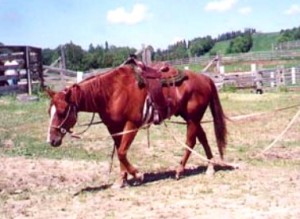 This is the third post in a series on how to train a horse. Every horse is different and might require a different method or more work in one area than another, so consider this just an overview. This advice is not meant to be a beginner’s only resource—I always suggest that a person find a mentor in the horse training business, and watch from a safe distance before they ever try starting a colt themselves.
This is the third post in a series on how to train a horse. Every horse is different and might require a different method or more work in one area than another, so consider this just an overview. This advice is not meant to be a beginner’s only resource—I always suggest that a person find a mentor in the horse training business, and watch from a safe distance before they ever try starting a colt themselves.
While the first two posts focused on saddling and bitting a horse, this topic will cover ground driving, or long reining as some call it. Ground driving is an important step in preparing a young horse for being ridden, as it asks him to focus on the rider’s commands, yield to direct rein pressure, and covers the beginning basics of reining so that the first actual ride can be a much safer one. If your horse has a good understanding of the reining concept from the ground, there is a much better chance that he will respond better when he is ridden for the first time.
To get your horse set up to ground drive, you should first do a little groundwork to introduce the lines to him. I would suggest working in a round pen with a long cotton lead rope at first, and tossing the rope over his back, around his legs, under his tail, and everywhere. If he is going to spook from a rope touching him, it is better that he do it before the rope is attached to his mouth. So give him a chance to experience the rope touching his sides, over his back, under his feet, dragging beside him as you lead him, and pretty much everywhere a rope could go if he got tangled in it. If he shies from it, or shows any sign of fear, then gently repeat that action until he will stand still and tolerate it without any trouble.
Another helpful thing for your horse to know beforehand is how to lunge and obey your vocal cues for walk, trot, and canter. If you or your horse is not familiar with lunging, you can read my article on training your horse to lunge and perfect that skill before you start ground driving.
If you don’t have a set of long reins, you can make your own by purchasing cotton rope in two 17 foot lengths and metal snaps to tie to each rope. Or just use two nylon lunge lines. Start out in your round pen, or wherever you usually lunge your horse, and run your long rein through the stirrup of your saddle up to the rings of the horse’s bit and clip it there. Repeat for the other side. Position yourself behind the horse at a safe distance, hold the reins up off the ground at about hock level, and give the cue for “walk”, asking the horse to move around the pen.
You may need to use a lunge whip to encourage your horse to walk ahead of you. Use a verbal command such as “ck-ck-ck” with your tongue to ask him for movement at first, and if he doesn’t obey that easily, you might need to tap the ground with your whip. If he still doesn’t obey, tap his hindquarters, always maintaining a safe distance from his heels in case he decides to kick. If he moves forwards too quickly, try to slow him down by tightening the inside rein and keep him at a walk. It might take several attempts before the horse even understands that he is supposed to move ahead of you. Again, if he is adept at lunging, it will make this exercise much easier.
Your goal with ground driving is to train the horse in forward movement, simple turns, stops, and even backing up before ever getting on his back. This might require a lot of practice, as the reining concept is one of the most difficult steps of a colt’s training. Once the horse responds well to these commands, you can take him outside the round pen to get him used to more circumstances you might encounter while riding in the future.
Ground driving will give a horse an idea of what will be expected of him once he is ridden, and you won’t have to work quite so hard at teaching him to rein once you’re on his back. I think it’s a very valuable exercise because it eliminates some of the danger of getting on a colt for the first time. You will have much better control of a horse that has been ground driven, and that first ride will have a better chance at success.

